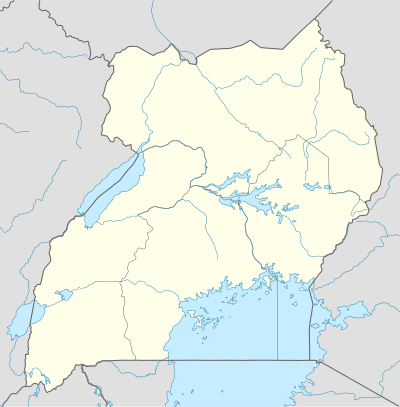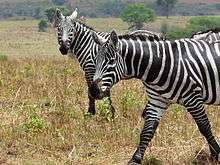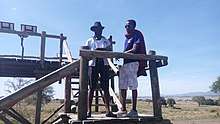Kidepo Valley National Park
Kidepo Valley National Park is a 1,442 square kilometres (557 sq mi) national park in the Karamoja region in northeast Uganda. Kidepo is rugged savannah, dominated by the 2,750 metres (9,020 ft) Mount Morungole and transected by the Kidepo and Narus rivers.
| Kidepo Valley National Park | |
|---|---|
IUCN category II (national park) | |
 | |
  Location of Kidepo Valley National Park | |
| Location | Karenga Karamoja, Northern Region, Uganda, Uganda |
| Coordinates | 03°54′N 33°51′E |
| Area | 1,442 km2 (557 sq mi) |
| Established | 1958 |
| Named for | from the Mening or Ketebo verb Kidebo, meaning ‘Help us |
| Operator | Uganda Wildlife Authority |
Location
Kidepo Valley National park is located near Karenga in Kaabong District, in the northeastern corner of Uganda. The park is approximately 220 kilometres (140 mi), by road northwest of Moroto, the largest town in the sub-region. It is approximately 520 kilometres (320 mi), by road, northeast of Kampala, Uganda's capital and largest city.[1]
The northwestern boundary of the park runs along the international frontier with Bira, South Sudan and abuts against its Kidepo Game Reserve
History
The Ketebo or Mening are the inhabitants farmers and hunters who lived in the area since 1800 before it was gazetted as a game reserve by the British colonial government in 1958. The purpose was both to protect the animals from hunting and to prevent further clearing of bush for tsetse fly-control.[2][3] The eviction of the resident people and the resultant famine, especially the Ketebo people who were forcefully relocated to other areas within Bira such as Napotpot, Kalo Kudo, Namosingo, Loriwo and Naurkori in South Sudan, is cited in contemporary protected area management as an example of the unacceptable consequences of not taking community needs into account when designating reserves.[4]
The newly independent government of Uganda under Milton Obote converted the reserve into the Kidepo Valley National Park in 1962. The first chief warden of the park was Ian Ross, a Briton. In 1972, Paul Ssali, a Ugandan, replaced him. Their handover and training was the subject of the 1974 American documentary film, "The Wild and the Brave."[5][6]
Geology
The park consists of the two major valley systems of the Kidepo and Narus Rivers. The valley floors lie between 3,000 feet (910 m) and 4,000 feet (1,200 m) AMSL.[7]
Kanangorok (also spelled Kananorok or Kanatarok) is a tepid hot spring in the extreme north of the park, in Lotukei, South Sudanese boundary. This spring is the most permanent source of water in the park.
The soil in the park is clayey. In the Kidepo Valley, black chalky clay and sandy-clay loam predominate, while the Narus Valley has freer-draining red clays and loams.[2]
Wildlife

Most of the park is open tree savannah. Because of differences in rainfall — with annual averages of 89 centimetres (35 in) in Narus and 64 centimetres (25 in) in the Kidepo basin — vegetation and animal populations vary between the two valleys.[8]
Narus Valley
Narus is a name given by the Ketebo or Mening and Amening Clan were the people living in the Valley. Primary grasses in the Narus Valley are the shorter red oat grass and taller bunchy Guinea grass and fine thatching grass.[2][7]
Common trees in the drier areas are red thorn acacias, desert dates, and to a lesser extent drumstick trees. The iconic sausage trees and fan palms line the water courses.[7] Euphorbia candelabrum and the shorter monkey bread (or camel's foot) and Buffalo thorn trees are also found.[8]
Perennial water makes River Kidepo an oasis in the semi-desert which hosts over 86 mammal species including spotted hyena, lion, cheetah, leopard, wild dog, elephant, giraffe, zebra, African buffalo, bat-eared foxes, Rothschild's giraffe — as well as almost 500 bird species.[9]
Kidepo Valley
Streams in the Kidepo Valley are likewise dotted with palms. Higher areas have whistling thorn acacias bush.[2]
Park management
The park is managed by the Uganda Wildlife Authority. The USAID as of August 2013 was financing the improvement of roads within the park.[10]
Leadership
The administration of the park is led by a Chief Warden. This position has been held by the following wardens:
- 1958–1962 Tony Henley[11]
- 1964–1972 Ian Ross
ODUR first black African to be chief park warden managed Kidepo in the 1960s before Paul Ssali
- 1972– ? Paul Ssali
- –1981 A.M.K. Bendebule (died in air crash in the park)[12]
- 1994– Peter Lotyang
- 1996 Anjelo Ajoka
- 1998 (acting) Daniel Aleper [13]
- 2001-2002 Joseph Sentongo [14]
- 2003-2006 Kuloao Okwongo [15]
Edward Asalu as chief park warden Capt. John Emille Otekat also worked as chief park warden
Finances
In the fiscal year 2009-2010 Kidepo received 294M Uganda Shillings (US$129k or €99k as of August 1, 2010) from 2100 visitors. By the 2012-2013 fiscal year this had grown to UGX 466M ($178k or €134k as of August 1, 2013) from 2300 visitors.[10]
Conservation activity
Giraffe

During the 1960s Kidepo had a sustainable Rothschild giraffe population of over 400 animals. By 1992 this had been poached down to only three animals, including a single female. In 1997 Warden Peter Möller obtained funding from the Frankfurt Zoological Society to translocate giraffes from Kenya's Lake Nakuru National Park. One female died in the holding facility in Lake Nakuru. Two females and one male were flown to Kidepo. In Kidepo one male was eaten by lions shortly after being released.[17]
Tourism
Game viewing is possible by vehicle on dirt roads that crisscross the southern and western parts of the park. A few trunk roads are improved with murram and are passable in all weather.
References
- Road Distance Between Kampala and Kidepo with Map
- Spinage, Clive Alfred (2012). African Ecology: Benchmarks and Historical Perspectives (1st ed.). Berlin: Springer. p. 710. ISBN 3642228712.
- Laban MacOpiyo (May 2011). Pastoralists’ Livelihoods In The Kidepo Valley Area of Northern Uganda (Report). African Union.
- Harmon, David (1998). J. Baird Callicott and Michael Nelson (ed.). Cultural Diversity, Human Subsistence, and the National Park Ideal. The Great New Wilderness Debate. Athens: University of Georgia. pp. 217–230.
- Ross, Jay (January 5, 1983). "Warden Task isn't Easy". The Washington Post.
- Heminway, John (1983). No man's land: the last of White Africa (1 ed.). New York: Dutton. p. 243. ISBN 0525241965.
- Ross, Iain; Harrington, G. (1968). "The practical aspects of implementing a controlled burning scheme in the Kidepo Valley National Park". East African Wildlife Journal. 6: 101–105. doi:10.1111/j.1365-2028.1968.tb00907.x.
- Field, C. R.; Ross, I. C. (1 March 1976). "The savanna ecology of Kidepo Valley National Park". African Journal of Ecology. 14 (1): 1–15. doi:10.1111/j.1365-2028.1976.tb00148.x.
- Fauna of Kidepo National Park
- Ssebuyira, Martin. "Kidepo national park posts growth in visitor numbers". Daily Monitor. Retrieved 14 August 2013.
- Wieland, Terry (2000). A view from a tall hill: Robert Ruark in Africa. Camden, Maine: Countrysport Press. ISBN 978-0892726509.
- "Obituaries: Kidepo Park officials" (PDF). IUCN Bulletin. IUCN: 26. March 1981. Retrieved 11 July 2012.
- Okech, Oscar (10 March 1998). "Uganda: Bush Fires Rage In Kidepo". New Vision. Retrieved 11 July 2012.
- "Uganda expects tourism boost".
- "About 2,000 Sudanese cross into Uganda to seek water". Retrieved 11 July 2012.
- "North Eastern Uganda- South Sudan Road Commissioned". Retrieved 11 July 2012.
- Kalema, Gladys (March 1998). Pritpal, Soorae (ed.). "Translocation of Rotschilds giraffes Giraffa camelopardalis rothschildi from Kenya to Uganda" (PDF). Re-introduction News. Nairobi: IUCN. 15: 8. Retrieved 11 July 2012.
External links
| Wikimedia Commons has media related to Kidepo Valley National Park. |
![]()